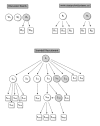Challenges of internet recruitment: a case study with disappointing results
- PMID: 15829478
- PMCID: PMC1550633
- DOI: 10.2196/jmir.7.1.e6
Challenges of internet recruitment: a case study with disappointing results
Abstract
Background: The Internet provides tremendous opportunities for innovative research, but few publications on the use of the Internet for recruiting study participants exist. This paper summarizes our experiences from 2 studies in which we attempted to recruit teenagers on the Internet for a questionnaire study to evaluate a smoking-cessation website.
Objective: To evaluate strategies of recruiting teenagers for the evaluation of a smoking-cessation website through the Internet.
Methods: In Study 1 (Defined Community Recruitment), we sent invitation emails to registered members of a youth health website, CyberIsle. A total of 3801 email addresses were randomly divided into 2 groups. In the first group, emails indicated that the first 30 respondents would receive a Can dollars 20 electronic gift certificate for use at an online bookstore if they would go to the Smoking Zine website and respond to a short survey. For the second group, the email also indicated that respondents would receive an additional Can dollars 10 gift certificate if they referred their friends to the study. Reminder emails were sent 10 days after the sending of the initial invitation email. In Study 2 (Open Recruitment), we posted invitation messages on Web discussion boards, Usenet forums, and one specialized recruitment website, and attempted a snowball recruiting strategy. When potential participants arrived at the study site, they were automatically randomized into either the higher incentives group (Can dollars 15 electronic gift certificate) or lower incentive group (Can dollars 5 gift certificate).
Results: In Study 1 (defined community recruitment), 2109 emails were successfully delivered. Only 5 subjects (0.24%), including 1 referred by a friend, passed the recruitment process and completed the questionnaire; a further 6 individuals visited the information page of the study but did not complete the study. In Study 2 (open recruitment), the number of users seeing the advertisement is unknown. A total of 35 users arrived at the website, of whom 14 participants were recruited (8 from the Can dollars 15 gift certificate group and 6 from the Can dollars 5 gift certificate group). Another 5 were recruited from the general Internet community (3 from discussion boards and 2 from the Research Volunteers website). The remaining 9 participants were recruited through friend referrals with the snowball strategy.
Conclusions: Overall, the recruitment rate was disappointingly low. In our case, recruitment using Internet technologies including email, electronic discussion boards, Usenet forums, and websites did not prove to be an effective approach for soliciting young subjects to participate in our research. Possible reasons are discussed, including the participants' perspective. A major challenge is to differentiate trustable and legitimate messages from spam and fraudulent misinformation on the Internet. From the researchers' perspective, approaches are needed to engage larger samples, to verify participants' attributes, and to evaluate and adjust for potential biases associated with Internet recruitment.
Conflict of interest statement
None declared.
Figures
References
-
- Skinner Harvey. Promoting Health through Organizational Change. San Francisco, Calif: Benjamin Cummings; 2001. Sep 14,
-
- Vanzyl A J, Cesnik B. The Internet and its role in teaching medical informatics to undergraduates. Medinfo. 1995;8 Pt 2(pt 2):1154–7. - PubMed
-
- Eysenbach Gunther, Wyatt Jeremy. Using the Internet for surveys and health research. J Med Internet Res. 2002 Nov 22;4(2):e13. doi: 10.2196/jmir.4.2.e13. http://www.jmir.org/2002/2/e13/ - DOI - PMC - PubMed
Publication types
MeSH terms
LinkOut - more resources
Full Text Sources




